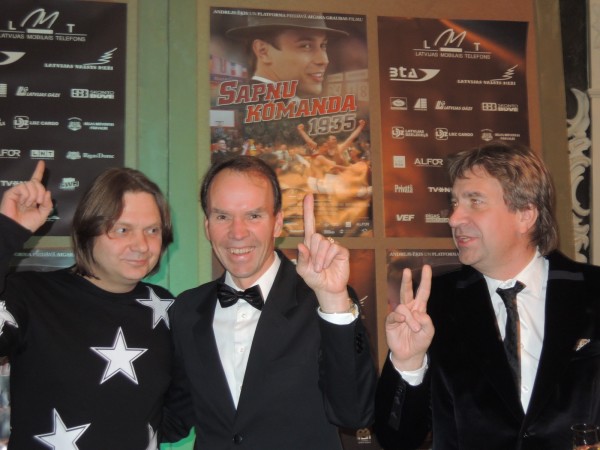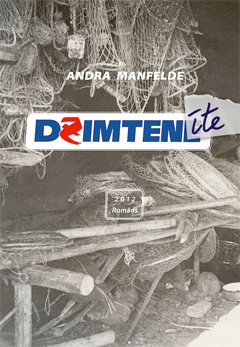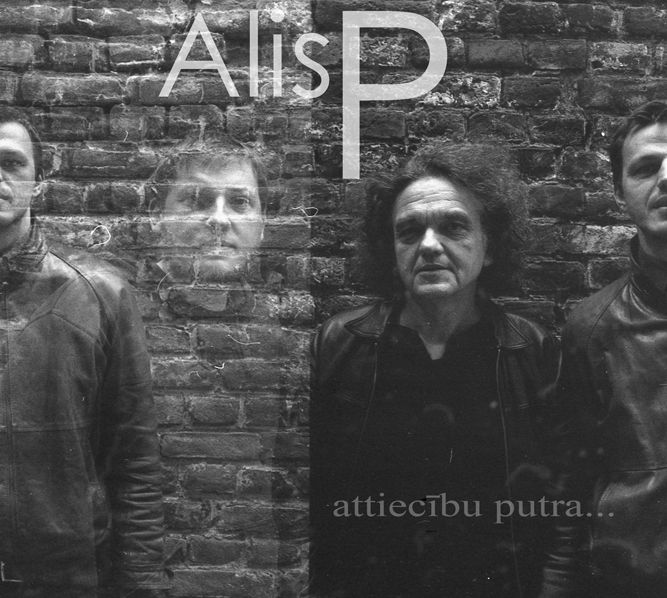
No kreisās režisors Aigars Grauba, LR goda konsuls Ņujorkā, Daris Dēliņš, producents Andrejs Ēķis. Foto: Lusīna Dēliņa.
Šogad, dienu pēc LR Valsts svetku svinībām Rīgā notika pirmizrāde producenta Andreja Ēķa un režisora Aigara Graubas jaunajai filmai Sapņu komanda 1935. Splendid Palace kinozālē, Elizabetas ielā pulcējās 600 ielūgti viesi, to skaitā 3 bijušie Latvijas prezidenti, Valsts ministri, filmas aktieri, veidotaji un filmas radīšanas sponsori.
Tā kā Ēķa un Graubas iepriekšējās filmas augsti novērtētas un slavētas (to skaitā, Baigā Vasara, Rīgas Sargi, Rūdolfa Mantojums), publikai bija lielas cerības, bet nezināja, vai šoreiz viņiem atkal laimēsies ar šo sniegumu.
Īsi par filmas saturu: pēc Pirmā pasaules kara, Eiropā vēl valdīja neziņa, kā Eiropas valstis un tās pilsoņi varēs sadzīvot. Vai miers turpināsies, vai atkal varētu būtu nesaprašanās un konflikts? Šajā periodā, tik dibināta Tautu Savienība (League of Nations) Ženēvā un valsts mēģināja pieturēties pie ASV Prezidenta Vudrova Vilsona (Woodrow Wilson) principiem, ka turpmāk starp lielvalstīm nesaprašanās tiktu atrisinātas pie galda, kādā forumā un, ja jaspēkojas, tad lai to dara nevis kara laukā, bet piemērotā sporta laukumā.
Divdesmitajos un trīsdemitajos gados basketbols kā sports sāka izplatīties Eiropā. To uz Eiropu bija atveduši ASV jūrnieki un Jaunatnes kristīgā savienība (t.s.YMCA) ap 1919 g. Šis sports lēnam sāka kļūt populārs. Bet lai pievērstu lielāku uzmanību un lai gatavotos basketbola iekļaušanai 1936.g. Olimpiadē Berlīnē, FIBA – Starptautiskā amatieru basketbola federācija Ženēvā gribēja sarīkot ģenerālmēģinājumu sacensību starp Eiropas valstīm pirms 1936.g. Olimpiades Berlīnē. Tāpēc 1935.g. maija sākumā tika rīkotas pirmās Eiropas basketbola starptautiskās sacensības Ženēvā. Visi gribēja būt uzvarētāji, ierakstīt savas valsts vārdu sporta vēsturē.
Latvijā tanī laikā arī bija jauni basketbola cienītāji un aktīvas komandas. Tur Armijas sporta kluba (ASK) treneris Valdemārs Baumanis zināja, ka Latvijai ir laba iespēja sadabūt kopā komandu un piedalīties Ženēvā pirmās meistarsacīkstēs. Bet, lai sasneigtu šo mērķi, Baumanim bija vispirms jāpārvar vairākus šķēršļus, to starpā vadošās sporta organizācijas pārstāvjus Rīgā, kam šī Latvijas piedalīšanās Ženēvas spēlēs likās kā pilnīga fantāzija.
Ceļš Baumanim un komandai uz Ženēvu nebija viegls, negāja arī viegli, kad tur beidzot nokļuva, gan ar spēlēm gan ar sadarbību ar FIBA birokratiem. 1935.g. Latvija bija maza valsts un neviens nedomāja, ka Latvija varētu sastādīt labu komandu.
Pirmās Eiropas basketbola sacensību uzvarētāji bija Baumaņa vadītā Latvijas komanda. Tas bija liels pārsteigums ne tikai visiem Ženēvā bet arī skeptiķiem Rīgā, ieskaitot dažus augstas rangas valsts institūcijas vadītājus.
Filma Sapņu komanda 1935 ir iespaidīga vairāku iemeslu dēļ. Tur parādīts maz pazīstams Latvijas vēstures posms un mūsu sportistu sasniegums internacionālajā laukā; tā ir saistoša sporta filma, kur skatītājs jau no pirmām ainām jūtas, ka pats sēž sporta zālē un izjūt visu spēles ātro ritmu, sasprindzinājumu par rezultātiem un spēlētāju sacensībām. Skatītājs arī izjūt fizisko darbu, kas katram spēlētājam bija jāieliek, lai sagatavotos spēlēm, ar cerību, ka viņu iekļaus izlases komandā un finālā. Filmā mēs arī piedzīvojam spēkošanos starp treneri Baumani, kam ir pārliecība, ka Latvijas komanda ir konkurētspējīga, bet viņu draud samalt birokrātiskās dzirnavas, jo ir elementi valsts institūcijās, kas cenšas viņa plānus nostumt no ceļa, jo tas nav dažu vadošo spēku interesēs.
Vēsturnieki filmā varēs arī saskatīt interesantas paralēles ar šodienu. Proti, pēc Pirmā pasaules kara dažiem bija vīzija kā Eiropas kopienu dibināt un stiprināt, kā pēc kara posta varētu uzbuvēt stiprāku un vienotu Eiropas kopvalsti, kur visas valstis būtu vienlīdzīgas. Visām valstīm būs tās pašas tiesības un pienākumi, tā lai nebūtu atkal nesaprašanās, kas varētu novest pie konflikta ar neparedzētām sekām. Bet, kā zinām, pēc 1935.g. sekoja 1936.g. – “Hitlera” Berlīnes Olimpiāde un pēc tam atkal tumšs periods Eiropas un pasaules vēsturē, kad sākās Otrais pasaules kaŗš. Kaut 1935. gadā Latvija bija neatkarīga un attīstīta valsts, daži neuzskatīja Latviju kā pilnvērtīgu Eiropas valstu dalībnieku. Mums bija jācenšas daudz vairāk, lai mēs varētu pieradīt, ka mēs spējam ko sasniegt, kaut esam maza valsts. Un neskatoties uz visiem iekšējiem un ārējiem šķēršļiem, Latvija un Baumanis uzvarēja Ženēvā.
Šodien Eiropā var vilkt līdzīgas paralēles. Top ekonomiskā krīze vairākās valstīs, Latvija vēl arvien ir maza valsts, bet spītējot visiem skeptiķiem ir jau savas krīzes periodu pārvarējusi un Latvijā atkal sācies attīstības posms. Tuvojoties 2013.gadam, paceļas jautājums – vai Eiropas kopiena varēs turēties kopā, un kādā veidā tā pastāvēs, jo ir domstarpības Eiropā par sadarbību nākotnē, kas ir vērtīgs “kluba” biedrs, un kas varbūt nav.
Sapņu komanda 1935 būs pievilcīga filma vairakām kino filmu skatītāju grupām – un tas ir filmas izcilākais sasniegums. Ja esi sporta – īpaši basketbola – cienītājs, tad filma noteikti patiks. Filma ir tanī pašā līmenī kā sekmīgas Holivudas filmas, kā piemēram Glory Road (2006), Cool Runnings (1993). Ja interesē Latvijas vēsture un mūsu valsts sasniegumi, tad filma sniedz ieskatu notikumos, par cilvēkiem, par Latviju un Eiropu trīsdesmitajos gados. Ja interesē Eiropas vēsture un paralēles ar šodienas notikumiem Eiropā, tad filma arī atver logu šinī virzienā.
Ēķa un Graubas filma mums atkal pierāda, ka Latvija un latvieši ir šodien konkurētspējīgi gan Eiropas, gan pasaules filmu tirgū. Sapņu komanda 1935 ir veidota Holivudas stilā un līmenī no visiem skatpunktiems – filmēšanas, tēlošanas, kostīmiem, apgaismošanas, vizuāliem efektiem, mūzikas, un skaņas.
Drīzumā plānots veidot internacionālu filmas versiju – Dream Team 1935. Ar skatu uz pasaules lielāko mērķauditorijas tirgu, paredzēts filmu dublēt angļu valodā, tā lai tā ir viegli pieejama vislielākajam skatītāju skaitam. Skatoties no Latvijas eksporta veicināšanas viedokļa, iecere filmu producēt starptautiskam tirgum parāda, ka latvieši skatās ārpus Latvijas un meklē vislielāko potenciālu saviem ražojumiem.
Filmu producenti Latvijā ir apjēguši, ka nevar ražot filmas tikai Latvijas kino skatītājiem. Ja vēlamies iekļūt pasaules tirgū un konkurēt ar savu preci, vajag sniegt kaut ko, kas rezonēs ne tikai mājās Rīgā, bet arī Berlīnē, Ženēvā, Londonā, Toronto, Ņujorkā, Čikāgā, Delessā, Losadželosā, Singapūrā, Sidnejā, un Melburnā. Visur pasaulē nedzīvo latvieši, bet visur ir skatītāji, kam interesētu filmas stāsts, īpaši basketbols. Basketbola audience pasaulē ir miljonos!
Filmas izrādes tagad sākušās Latvijā. Latvieši ārzemēs varēs redzēt filmu jau 2013. gada sākumā un drīz pēc tam sekos dublētās filmas Dream Team 1935izrādes ASV kinocentros un citās zemēs.
Par filmu var vairāk lasīt tīmeklī: http://www.sapnukomanda.lv
Details







